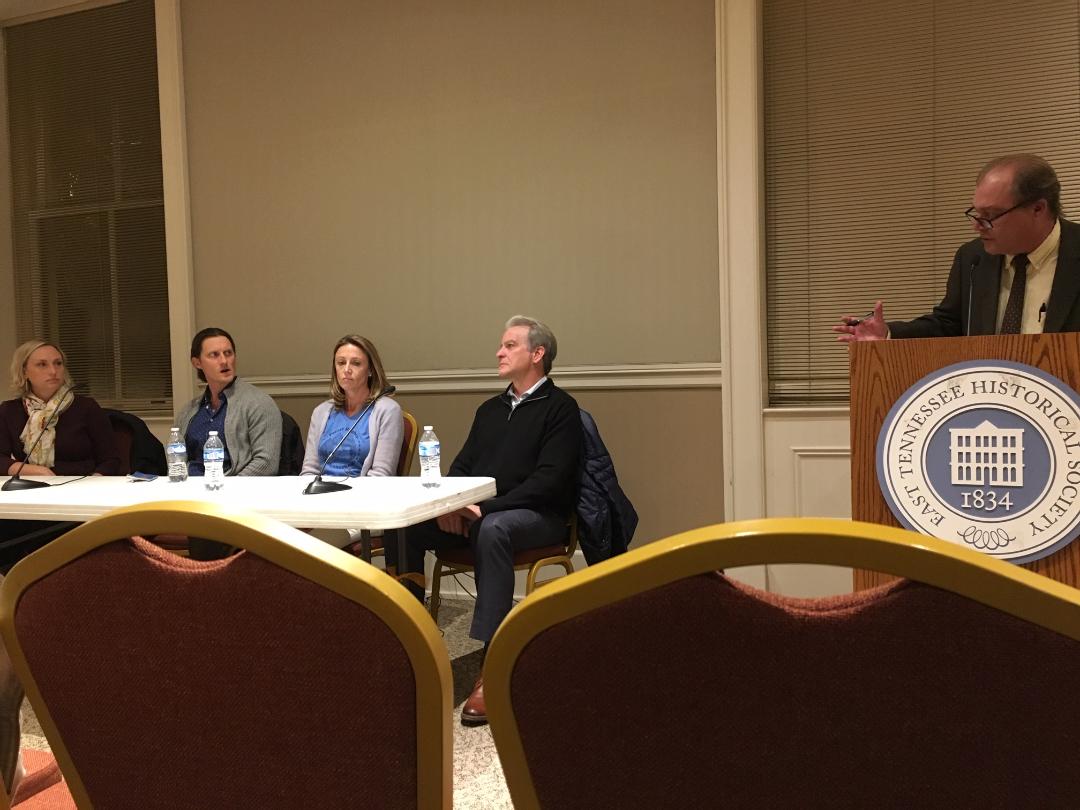On Nov. 26, a public panel discussion about issues of concern to Realtors and developers regarding Recode Knoxville was hosted by Compass at the East Tennessee History Center. The panel included MPC executive director Gerald Green, Realtor Jennifer Roche, home builder Matt Sterling and community stakeholder advisory committee representative Amy Midis. The main focus was on increased density, affordable housing, accessory dwelling units (ADUs), commercial building heights near residences and the impact of building standards. The schedule going forward was also discussed. An audience question-and-answer session followed.
The producers of Compass (a new, subscriber-only online newsletter about local government, politics and business), Scott Barker and Jesse Mayshark, planned the event for the Knoxville Area Association of Realtors, and they moderated the discussion and managed the Q&A session, respectively.
Schedule. Green described the impetus for undertaking Recode to replace the existing zoning laws and outlined the remaining drafting and approval schedule.
- The fourth, cleaned-up or final draft of the code and the associated map will be released in early to mid-December, and it will be presented to the full Metropolitan Planning Commission at the regular December or January MPC meeting.
- There will likely be several interim workshops involving the stakeholder advisory committee and the commission, but there are no general public presentation meetings planned. Workshops will be open to the public.
- Written comments will still be accepted on the revised draft. Green said, after 67 public meetings, the staff understands the public’s concerns.
- When asked, Vice Mayor Finnbar Saunders stated that City Council plans at least two workshops (covering residential and commercial/industrial topics) starting later in January, and others will be held if Council wishes.
- The East Tennessee Design Center will host an architects’ charette on Jan. 29 to illustrate a half-dozen difficult design situations under Recode, and the public will be invited to view them later that evening.
- In response to questions, Green said the Recode effort should be wrapped up during the first quarter of 2019.
- Check here for a meeting schedule. The city will also issue press announcements.
More Time? Several audience members said MPC needed to move slower, and perhaps even break up the code into several segments for separate action, in order to make this stuff more understandable. A speaker from Vestal added that folks in her neighborhood have had trouble attending the existing meetings due to work and family obligations, and it takes time to comprehend some of the technical terminology. Green replied that they have held meetings at various times of the day and in different neighborhoods to spread the information and obtain comments (some 600 have been received). The code is one document, integrated in its parts, and it can’t be adopted in segments. He analogized: “When you go to the hospital for a birth, you don’t bring home half a baby.”
Density and Affordable Housing. It was said that Knoxville is growing, that more affordable housing is needed, and that ADUs and multifamily zones like RN3 and RN4 will help meet that need. Sterling said that we can find ways to build more affordable duplexes and triplexes, townhouses and other multifamily housing in existing neighborhoods without harming the character of the neighborhoods. “Nobody wants bad housing,” he said, and we can develop standards to assure such development and growth is good. Sterling added that house construction costs are rising by 1 percent per month, so there is a need to contain them. Roche cautioned that overly strict standards can raise housing prices. She said Knoxville does not have an adequate supply, especially in the lower price range, to meet current demand.
In another segment, Green noted that they have decided to drop design standards for houses (e.g., whether the garage should sit back several feet from the house front) as unnecessary. The focus has been to address blending taller commercial buildings (up to 70 feet) with nearby residences with larger setbacks and a step down in height based on proximity to the houses.
Neighborhood Pushback. The audience raised questions about adding more density to existing neighborhoods, many of which do not have adequate roads or parking for more vehicles. Some wondered about the impact on crowded schools.
David Nix, a 20-year resident of Parkridge, said he became concerned in August when the second map edition was released, placing much of his neighborhood in an RN4 zone. The neighborhood has more than 20 apartment and multifamily units, and it is already difficult to park near your home. Adding ADUs and more units will force neighbors to pave their backyards in order to squeeze in more cars. Had he known of such changes in advance, he would never have moved here from Alabama and spent years fixing up his older home. He added, “There is only so many taters that will fit in a bag!”
Green stated that they have received these comments and have already begun revising the earlier broad-brush RN4 designations that might affect Parkridge and Oakwood Lincoln Park. They want to protect the integrity of existing neighborhoods, and he repeated that most high-density development belongs along the corridors, where public transportation and retail exist.
When asked about remaining concerns, Midis said many of the neighborhoods she has met with expressed worries about what their neighbors might do if some of these changes were widely allowed. Protecting single-family neighborhoods was a major concern. She noted that it is hard to specify uniform rules as “every area has special needs and wants.”
As to the ADU controversy, Green responded that MPC is now planning to restrict ADUs to owner-occupied property in the redraft. That’s a needed compromise. But he reminded everyone that Knoxville needs to be prepared for 21st-century development. So there will be more mixed-use and multifamily development. Again, corridors are some of the best places to do that.
The issue of more sidewalks was raised, but it is not addressed in Recode. The city is reviewing that issue separately. Audience members confirmed that younger families are looking for more walkable areas where they live.
Reuse of Commercial Properties. Green said that one of the focal points of Recode was to facilitate redevelopment of aging commercial properties. Too much current development has been forced to rely on seeking variances and other costly rezoning measures to get underway. Such delays affect the cost and feasibility of reuse. MPC has tried to address that in Recode. That is especially true along Kingston Pike, Central Street and Broadway. We need to be ready for the next decade and for the successful reuse of older commercial and industrial properties. Several panelists added that growing the tax base will enable Knoxville to address its other needs, like more affordable housing. The city currently has $2.5 million in its current budget for that effort. Green said zoning cannot create affordable housing, just make such uses open to private development.
Of course, much more was discussed during the nearly two-hour session. Be prepared to review the new code and map release in December. Continue to provide written comments to MPC and your City Council reps. We all want the best code we can fashion for our future. Remember the old adage: If you are not at the table, you may be on the menu.

